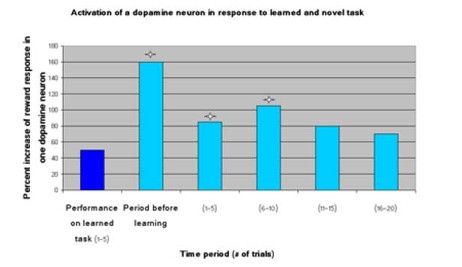Last week in WAGER 8 (30), we introduced a special series on biology, addiction, and gambling. We noted that the “reward system” of the brain, which can create pleasurable feelings through a release of dopamine, might play a role in the development of addiction. In this week’s WAGER, we review a study that demonstrates how specific areas of the brain associated with dopamine systems, the substantia nigra and the ventral tegmental area, respond to different decision-making scenarios, revealing potentially important implications for research on gambling behavior (see Figure 1)(Hollerman & Schultz, 1998).
Figure 1. Diagram of areas of the brain associated with the reward system
Experimenters sat two Japanese macaque monkeys (Macaca fascicularis) at a computer screen in front of a series of paired color pictures. The monkeys’ task was to learn via trial and error and memorization which pictures symbolized a reward. During each trial, the researchers rewarded the subject for touching a lever below the “correct” picture by distributing a squirt of apple juice, but did not reward the subject for touching a lever below the “incorrect” picture. The pictures were randomly assigned to correct and incorrect groups before the experiment. Once the monkeys learned the first set of pictures, the experimenters added new pictures for the monkeys to learn. Researchers examined individual dopamine neurons using standard electrophysiological techniques as the monkeys gradually learned to distinguish between the new correct and incorrect pictures for about 20 trials.
The first stage of the trials, where the monkeys were still learning which picture to choose, was defined as the learning “criterion.” “Before criterion” refers to the period before the monkeys learned which picture was correct and incorrect and their choosing of pictures was somewhat random. “After criterion” refers to the period during which the monkeys knew correct from incorrect and their choosing was not random. Gradually, the subjects learned to distinguish the correct images from the incorrect images.
Figure 2. Time period versus percent increase in the activation of one dopamine receptor.

As seen in Figure 2, the percent of reward responses differed significantly across trials, p < .025. The first bar represents a reward for the trials where monkeys knew which pictures were correct, the second bar represents a response to an unexpected reward, successive bars represent a response to a gradually predicted reward. Post-hoc tests compared dopamine response to familiar pictures to the response at successive stages of learning, (significant differences of p < .05 indicated with a star). The response to unexpected reward showed the largest spike in dopamine response. As learning increased, dopamine reactivity decreased. After ten trials, dopamine response was not significantly greater than the response to learned pictures. Overall, dopamine neurons showed a positive response (excitation) to either an unpredicted reward or a reward given during initial learning stages, no response when a predicted outcome occurred, and a negative response (depression) when a reward failed to occur because of choice errors. The authors suggest that this development illustrates that dopamine neurons gradually reflect the subject’s learning curve by encoding the unpredictability of reward outcomes and follow its decrease as learning increases.
Because 20 trials were tested for each novel picture, results displayed a spiked dopamine activation level followed by a gradual decrease of activation. It is uncertain whether some tasks chronically activate dopaminergic systems and what effect this could have on organisms. Also, these tests utilized a task with favorable odds for the subject: 50:50; it remains to be seen whether a task with less favorable odds would yield the same dopamine response to subject learning.
This study, among others, reflects dopamine neurons as instrumental in reward-driven behavior. An unexpected reward can produce a large spike in dopamine reactivity whereas expected rewards overtime show declining reactivity. With more testing, dopamine neurotransmitters’ positive reaction to random reinforcement might be applied to gambling, illuminating how the uncertainty and novelty of gambling elicits excitement in the player. This excitement gradually decreases over time, perhaps suggesting how gamblers continually need to raise their stakes or change games to keep the novelty of the game alive.
Comments on this article can be addressed to Michael Stanton
References
Hollerman, J. R., & Schultz, W. (1998). Dopamine neurons report an error in the temporal prediction of reward during learning. Nature neuroscience, 1(4), 304
309.
The WAGER is a public education project of the Division on Addictions at Harvard
Medical School. It is funded, in part, by the National Center for Responsible
Gaming, the Massachusetts Department of Public Health, the Substance Abuse and
Mental Health Services Administration, and the Center for Substance Abuse
Treatment.





